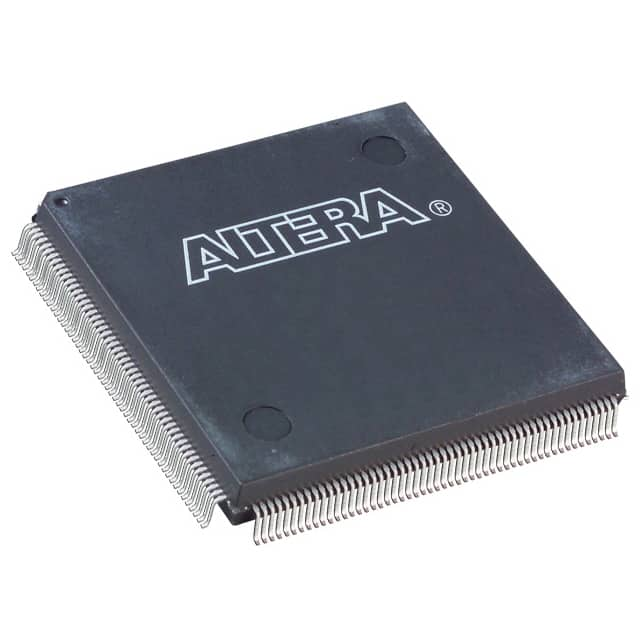Xem thông số kỹ thuật để biết chi tiết sản phẩm.

EPF10K30EQC208-2N
Product Overview
Category: Programmable Logic Device (PLD)
Use: The EPF10K30EQC208-2N is a PLD designed for digital logic applications. It offers high-performance and flexibility, making it suitable for various electronic systems.
Characteristics: - High-density programmable logic device - Advanced architecture for efficient implementation of complex designs - Low power consumption - Fast speed operation - Easy integration with other components
Package: The EPF10K30EQC208-2N comes in a 208-pin Quad Flat Package (QFP), which provides a compact and reliable form factor for easy installation and connection.
Essence: This PLD is built to provide designers with a versatile and powerful tool for implementing complex digital logic circuits. It offers a wide range of features and capabilities to meet the demands of modern electronic systems.
Packaging/Quantity: The EPF10K30EQC208-2N is typically sold individually or in small quantities, depending on the supplier's packaging options.
Specifications
- Logic Elements: 30,000
- Maximum User I/Os: 208
- Operating Voltage: 3.3V
- Speed Grade: -2 (Fastest)
- Embedded Memory: Up to 288 kilobits
- Clock Management: Phase-Locked Loops (PLLs)
- Configuration Method: SRAM-based
Detailed Pin Configuration
The EPF10K30EQC208-2N has 208 pins, each serving a specific purpose in the device's functionality. The pin configuration includes input/output pins, clock pins, power supply pins, and configuration pins. For a detailed pinout diagram and description, refer to the manufacturer's datasheet.
Functional Features
High-Density Logic: The EPF10K30EQC208-2N offers a large number of logic elements, allowing for the implementation of complex digital circuits in a single device.
Flexible I/O Configuration: With 208 user I/O pins, this PLD provides ample flexibility for interfacing with external devices and components.
Fast Operation: The -2 speed grade ensures high-speed performance, enabling efficient execution of time-critical operations.
Low Power Consumption: The device is designed to minimize power consumption, making it suitable for battery-powered applications or energy-efficient systems.
Versatile Clock Management: The integrated PLLs enable precise clock generation and synchronization, facilitating reliable timing control in the circuit.
Advantages and Disadvantages
Advantages: - High-density logic elements allow for complex designs. - Flexible I/O configuration enables versatile interfacing options. - Fast operation ensures efficient execution of time-critical tasks. - Low power consumption contributes to energy-efficient systems. - Versatile clock management enhances timing control.
Disadvantages: - Limited embedded memory compared to some other PLDs. - Higher cost compared to simpler programmable logic devices. - Steeper learning curve for beginners due to its advanced features.
Working Principles
The EPF10K30EQC208-2N operates based on the principles of programmable logic. It consists of an array of configurable logic blocks interconnected through programmable interconnect resources. These resources allow designers to create custom logic functions by configuring the connections between logic elements.
During operation, the PLD is programmed using a hardware description language (HDL) or a graphical design tool. The programming defines the desired logic functions and interconnections within the device. Once programmed, the PLD executes the defined logic operations, responding to input signals and generating output signals accordingly.
Detailed Application Field Plans
The EPF10K30EQC208-2N finds applications in various fields, including:
Embedded Systems: The PLD can be used in embedded systems to implement custom logic functions and interface with other components.
Communications: It can be utilized in communication systems for protocol handling, data processing, and signal conditioning.
Industrial Automation: The device is suitable for industrial automation applications, enabling control and monitoring of complex processes.
Consumer Electronics: It can be integrated into consumer electronic devices for implementing specialized features and enhancing overall functionality.
Detailed and Complete Alternative Models
EPF10K50EQC240-3N: A higher-density version of the EPF10K30EQC208-2N, offering 50,000 logic elements and increased I/O capabilities.
EPF10K20RC240-4N: A lower-density variant with 20,000 logic elements, suitable for less complex designs or cost-sensitive applications.
EPF10K100ABC356-1N: A higher-performance model with 100,000 logic elements and advanced features, catering to demanding applications.
These alternative
Liệt kê 10 câu hỏi và câu trả lời thường gặp liên quan đến ứng dụng EPF10K30EQC208-2N trong giải pháp kỹ thuật
Sure! Here are 10 common questions and answers related to the application of EPF10K30EQC208-2N in technical solutions:
Q: What is EPF10K30EQC208-2N? A: EPF10K30EQC208-2N is a specific model of Field Programmable Gate Array (FPGA) manufactured by Intel.
Q: What are the key features of EPF10K30EQC208-2N? A: Some key features of EPF10K30EQC208-2N include 10,000 logic elements, 30,000 gates, 208-pin Quad Flat Package (QFP), and 2.5V core voltage.
Q: What are the typical applications of EPF10K30EQC208-2N? A: EPF10K30EQC208-2N can be used in various technical solutions such as digital signal processing, telecommunications, industrial automation, robotics, and embedded systems.
Q: How does EPF10K30EQC208-2N differ from other FPGA models? A: EPF10K30EQC208-2N has its own unique combination of logic elements, gates, pin configuration, and voltage requirements, which differentiate it from other FPGA models.
Q: Can EPF10K30EQC208-2N be programmed? A: Yes, EPF10K30EQC208-2N is a field programmable device, meaning it can be reprogrammed to implement different logic functions and configurations.
Q: What programming languages can be used with EPF10K30EQC208-2N? A: EPF10K30EQC208-2N can be programmed using Hardware Description Languages (HDLs) such as VHDL or Verilog.
Q: Are there any development tools available for EPF10K30EQC208-2N? A: Yes, Intel provides development tools like Quartus Prime software suite that supports EPF10K30EQC208-2N and helps in designing, simulating, and programming the FPGA.
Q: Can EPF10K30EQC208-2N interface with other components or devices? A: Yes, EPF10K30EQC208-2N can interface with various peripherals and devices through its I/O pins, allowing communication and integration with other components in a system.
Q: What are the power requirements for EPF10K30EQC208-2N? A: EPF10K30EQC208-2N operates at a core voltage of 2.5V and requires appropriate power supply and decoupling capacitors as per the manufacturer's guidelines.
Q: Where can I find more information about EPF10K30EQC208-2N? A: You can refer to the datasheet, user manual, application notes, and online resources provided by Intel for detailed information on EPF10K30EQC208-2N and its applications.

